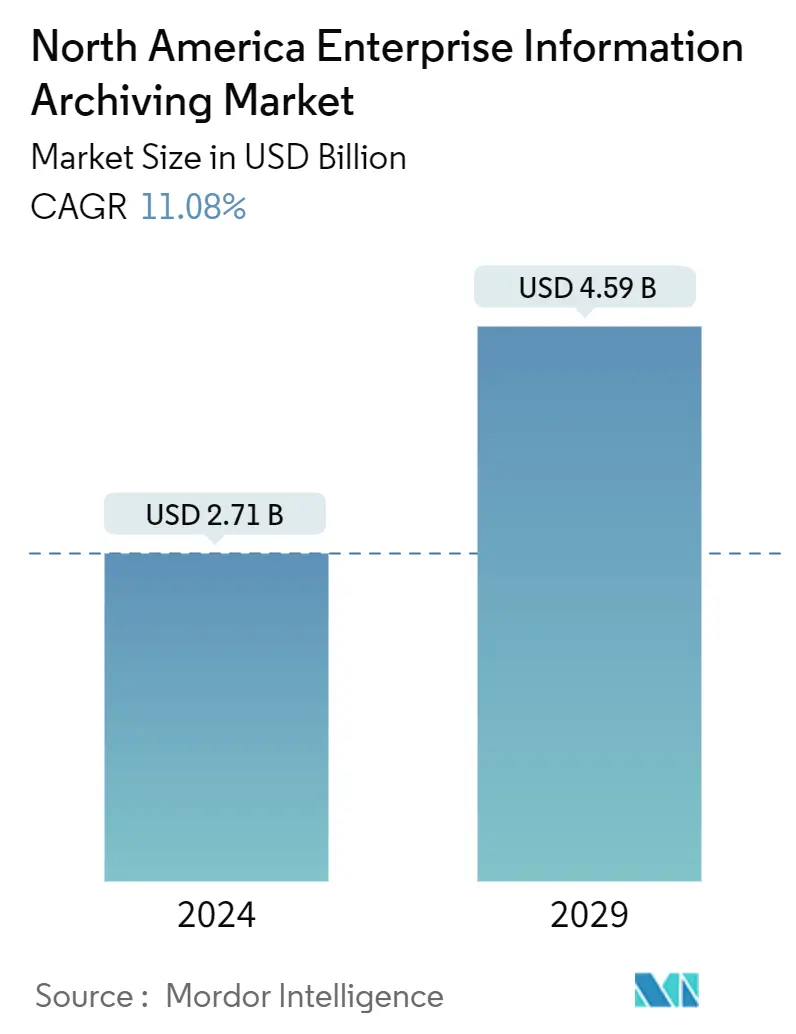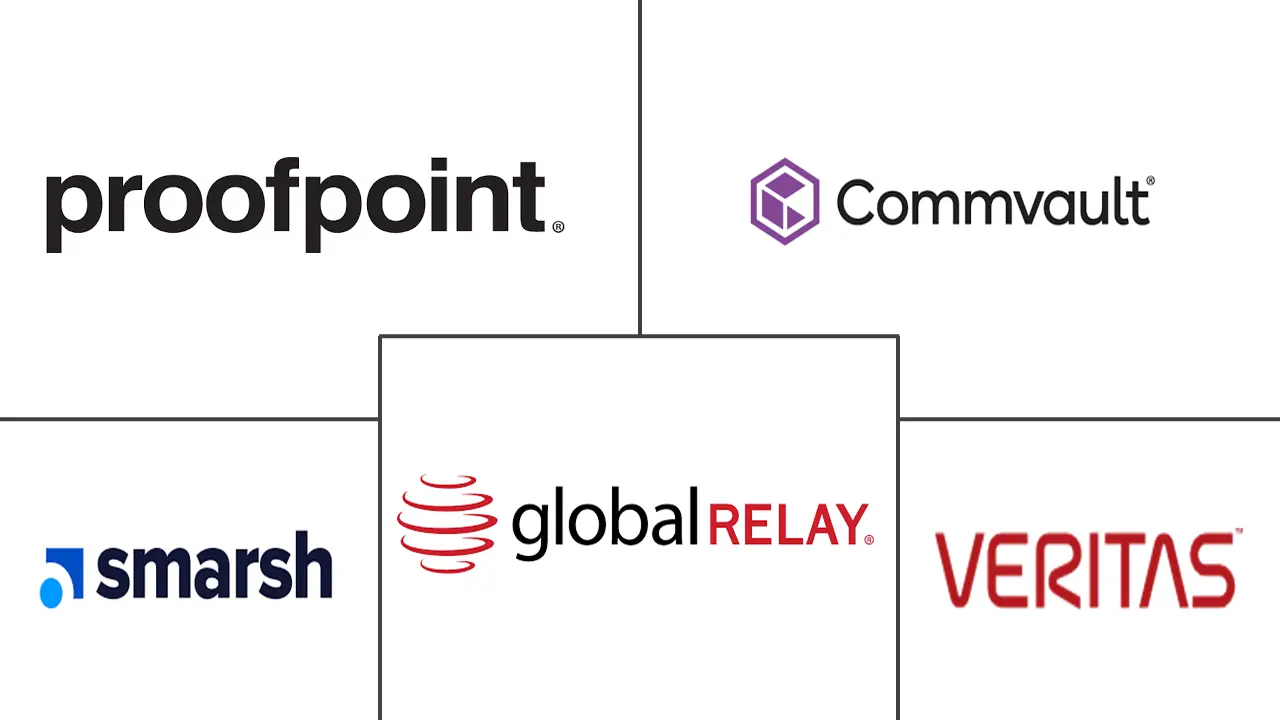Market Size of North America Enterprise Information Archiving Industry

| Study Period | 2019 - 2029 |
| Base Year For Estimation | 2023 |
| Market Size (2024) | USD 2.71 Billion |
| Market Size (2029) | USD 4.59 Billion |
| CAGR (2024 - 2029) | 11.08 % |
| Market Concentration | Low |
Major Players
*Disclaimer: Major Players sorted in no particular order |
North America Enterprise Information Archiving Market Analysis
The North America Enterprise Information Archiving Market size is estimated at USD 2.71 billion in 2024, and is expected to reach USD 4.59 billion by 2029, growing at a CAGR of 11.08% during the forecast period (2024-2029).
- Data generated by enterprises across the region includes mainly unstructured and structured data. This data is bifurcated into various formats, from structured, numeric data in traditional databases to unstructured text documents, videos, audio, e-mails, stock ticker data, and financial transactions. The enterprise information archiving solutions store all data in the archive storage and make it accessible when required. As organizations have positioned themselves to extract more value, intelligence, and utility from the data, these solutions are expected to grow during the forecast period.
- These archiving solutions primarily address the increasing issue of how to store structured and unstructured data. Traditionally, the corporate databases contained only structured data stored in defined tables for consistency.
- However, with archiving solutions, companies have been looking at ways to keep their unstructured data, e.g., PowerPoint and SharePoint files, which contain a lot of corporate data in a combination of text and visual components. As these data sources are less structured, they need other archiving, storage, and retrieval methods, driving the demand for information archiving tools and resources to accommodate the archiving of diverse materials.
- Many enterprise archival processes are being managed on-premise, primarily owing to multiple factors, including risk and regulation. However, on-premise data archiving is increasingly becoming an unfeasible option and will not be sustainable in the face of the incoming data deluge. Enterprise information archiving solutions enable users to write the rules for archiving and storing data safely and effectively in different environments.
- These solutions also present the ability to choose the appropriate model that delivers clear and quantifiable benefits, allowing users, for example, to take advantage of the lower cost storage where regulation allows while retaining the on-premise options where stipulated. The massive volume of content and information kept inside the businesses using traditional storage solutions is expected to become a problem for an organization that constantly upgrades its infrastructure.
- There is a greater need for business goods and services during economic expansion. Due to this increase in activity, businesses frequently invest in technology like Enterprise Information Archiving (EIA) systems that can increase productivity and operational efficiency. The goal is to streamline operations, cut expenses, and put the company in a position for long-term success. According to a World Bank estimate, the North American GDP, which was USD 32.32 trillion in 2023, is predicted to increase by 1.5% in 2023-24, suggesting that corporate activity and possible Enterprise Information Archiving (EIA) system investments are projected to flourish.
North America Enterprise Information Archiving Industry Segmentation
Enterprise information archiving (EIA) solutions to meet information governance requirements, including regulatory and legal requirements, corporate governance, and privacy, as well as to improve data accessibility, surface new data insights, and operational efficiency. It is designed to archive data sources to a central platform.
The North American enterprise information archiving market is segmented by offering (software, service), deployment (cloud, on-premises), organization size (small and medium-sized enterprises, large enterprises), end-user industries (BFSI, IT and telecom, retail and E-commerce, healthcare, government, media and entertainment, education), country (United States, Canada). The market size and value (USD) forecasts for all the above segments are provided.
| By Offering | |
| Software | |
| Service |
| By Deployment | |
| Cloud | |
| On-premises |
| By Organization Size | |
| SMEs | |
| Large Enterprises |
| By End-user Industries | |
| BFSI | |
| IT and Telecom | |
| Retail and E-commerce | |
| Healthcare | |
| Government | |
| Media and Entertainment | |
| Education | |
| Other End-user Industries |
| By Country | |
| United States | |
| Canada |
North America Enterprise Information Archiving Market Size Summary
The North American enterprise information archiving market is poised for significant growth, driven by the increasing need to manage both structured and unstructured data generated by businesses across the region. As organizations strive to extract more value from their data, the demand for archiving solutions that can efficiently store and retrieve diverse data formats, including text documents, videos, and financial transactions, is on the rise. These solutions are becoming essential as traditional on-premise storage methods struggle to keep up with the data deluge, prompting businesses to explore cloud-based options that offer scalability, cost savings, and regulatory compliance. The market is characterized by a strong focus on IT modernization and innovation, with major players like Microsoft, Barracuda Networks, and Proofpoint leading the charge in integrating advanced technologies such as AI and cloud services into their offerings.
The adoption of cloud computing is further accelerating the growth of the enterprise information archiving market in North America, as businesses seek to leverage the agility and flexibility of cloud platforms. The region's early adoption of technological advancements and the presence of robust regulatory frameworks have positioned it as a leader in the market. The increasing use of IoT in sectors like healthcare is also driving demand, as organizations need to store sensitive data for extended periods. Government regulations and standards play a crucial role in shaping market dynamics, with vendors increasingly adopting recognized cloud platforms to ensure uninterrupted service delivery. The market remains fragmented, with established tech giants holding a competitive edge over new entrants, and ongoing partnerships and innovations continue to shape the landscape.
North America Enterprise Information Archiving Market Size - Table of Contents
-
1. MARKET INSIGHTS
-
1.1 Market Overview
-
1.2 Industry Attractiveness - Porter's Five Forces Analysis
-
1.2.1 Bargaining Power of Suppliers
-
1.2.2 Bargaining Power of Consumers
-
1.2.3 Threat of New Entrants
-
1.2.4 Threat of Substitutes
-
1.2.5 Intensity of Competitive Rivalry
-
-
1.3 Analysis of Impact of Macroeconomic Trends
-
-
2. MARKET SEGMENTATION
-
2.1 By Offering
-
2.1.1 Software
-
2.1.2 Service
-
-
2.2 By Deployment
-
2.2.1 Cloud
-
2.2.2 On-premises
-
-
2.3 By Organization Size
-
2.3.1 SMEs
-
2.3.2 Large Enterprises
-
-
2.4 By End-user Industries
-
2.4.1 BFSI
-
2.4.2 IT and Telecom
-
2.4.3 Retail and E-commerce
-
2.4.4 Healthcare
-
2.4.5 Government
-
2.4.6 Media and Entertainment
-
2.4.7 Education
-
2.4.8 Other End-user Industries
-
-
2.5 By Country
-
2.5.1 United States
-
2.5.2 Canada
-
-
North America Enterprise Information Archiving Market Size FAQs
How big is the North America Enterprise Information Archiving Market?
The North America Enterprise Information Archiving Market size is expected to reach USD 2.71 billion in 2024 and grow at a CAGR of 11.08% to reach USD 4.59 billion by 2029.
What is the current North America Enterprise Information Archiving Market size?
In 2024, the North America Enterprise Information Archiving Market size is expected to reach USD 2.71 billion.

